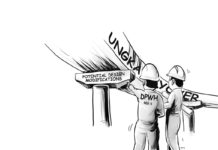[av_one_full first min_height=” vertical_alignment=” space=” custom_margin=” margin=’0px’ padding=’0px’ border=” border_color=” radius=’0px’ background_color=” src=” background_position=’top left’ background_repeat=’no-repeat’ animation=”]
[av_heading heading=’Hablon strands’ tag=’h3′ style=’blockquote modern-quote’ size=’30’ subheading_active=’subheading_below’ subheading_size=’18’ padding=’10’ color=” custom_font=” av-medium-font-size-title=” av-small-font-size-title=” av-mini-font-size-title=” av-medium-font-size=” av-small-font-size=” av-mini-font-size=” admin_preview_bg=”]
BY RHICK LARS VLADIMIR ALBAY
[/av_heading]
[av_textblock size=” font_color=” color=” av-medium-font-size=” av-small-font-size=” av-mini-font-size=” admin_preview_bg=”]
February 17, 2018
[/av_textblock]
[av_textblock size=’18’ font_color=” color=” av-medium-font-size=” av-small-font-size=” av-mini-font-size=” admin_preview_bg=”]
IT’S fascinating to think that each bolt of cloth is made up of untold minute threads. Hundreds, maybe even thousands of filaments meticulously put together, every single one adding to the awe of the whole. Horizontal and vertical spectrums meeting at right angles to form patterns. Long strands running down the length of the fabric, threads that flow like rivers.
Long strands that once passed through the fingers of a weaver, taught at a young age the dance of threads, how each one must be manipulated to be put into place. For many generations, such has been passed on from mother to daughter. An inheritance interlaced with tales and myths, some fading away after neglect, some growing with the children of the weavers.
One such story is recounted in Mandaya folklore. It speaks of how a young woman stumbled upon a beautiful fabric on the trunk of gnarled Balete tree, by a river that ran calm like soft threads; and how a benevolent and gentle spirit, the Tagamaling, owner of the cloth, welcomed the woman into her earthen home bestowing unto her visitor the knowledge of weaving, then letting the woman return to her village, to propagate the art. The spirit whose name was whispered solemnly by the weavers of old, asking for skill and giving thanks, before starting on a new bolt of cloth.
I thought it only appropriate to murmur the name to myself before starting my journey. Like the early weavers with their antique looms, I must show my respect to the giving spirit.
Indag-an is roughly 4 kilometers from Miag-ao’s town proper. I boarded a tricycle at a terminal near Miag-ao Church. The Indag-an Primary Multipurpose Cooperative was a 10-minute ride away.
The welcoming thud of looms echoed through my ears as I entered the IPMC. Ample sunlight radiated on the colored threads and half-finished fabrics of the weavers. Inside the room were 10 looms crowded together in the narrow area. Strikingly about seven other looms were outside, placed there due to lack of space.
The Indag-an Primary Multi-purpose Cooperative was put up to support the local weavers of the barangay in 1990, and since then the cooperative has become a center for the weaving of Hablon, multi-colored fabrics made from jusi, silk, and piña fibers. LGUs of Miag-ao have shown unwavering support for project. Also, several local designers have incorporated Hablon into their pieces, renewing interest for the product. More than 20 years later, the IPMC still continues its operations in service of its weavers and members.
Among them is Aling Maryeta, who at 63 years of age, is the oldest member of the cooperative. Noticeable are her calloused fingers, worn out by her lifetime of weaving, yet surprising are their agility in handling threads. Born of an impoverished family, she had the chance to study only until Grade six. Early on she had to work to contribute to her family’s livelihood. Fostered by her aunt, she learned the art of weaving. She recalls having several looms or tiral as they are called in Hiligaynon, in their house as a child; some of them she claims have been in their family for more than a hundred years, passed from one generation to another, along with the designs and techniques of their ancestors.
She shares that through her efforts and the help of the cooperative, four of her children have taken up college degrees and are now employed teachers, with their own growing families. She admits to feeling aches and difficulties, but still strives to finish each and every bolt of cloth she starts.
I ask her how long she plans to continue her weaving. “Asta maglabog mata ko eh,” she answers smiling. Till her eyes finally fail her. “Beautifully said”, I say to myself.
As I walked away from the IPMC, waiting for a tricycle to pass, the muffled sound of looms continued to fill the air. I find shade beside a tall tree with knotted roots.
Weaving, an art form once held in grandeur is now fading away; slowly dying with each weaver that leaves this world. Bitter-sweet as it is; many of Aling Maryeta’s children have chosen to venture other roads, roads they see as having more opportunities, while only one has accepted her inheritance of the valued skill. The art of weaving is slowly fading away.
I recall Aling Maryeta’s words of continuing her craft until her sight fails her. I sincerely wish that day will never come, and that she’ll have a long and happy life. I pray to the Tagamaling to watch over her as she handles the many lengths of thread that goes through her nimble fingers. May she always be given the needed skill, energy, and patience to keep the thuds and sounds of wooden frames resonating. I wish for her to age like the looms of her childhood, more than a hundred years of life but still strong enough to hold the unbound threads of a cloth yet to be finished.
The late afternoon sun casts soft shadows on the asphalt road below my feet. The trike steadily moves farther and farther away from Indag-an./PN
[/av_textblock]
[/av_one_full]



